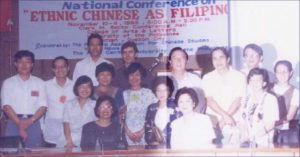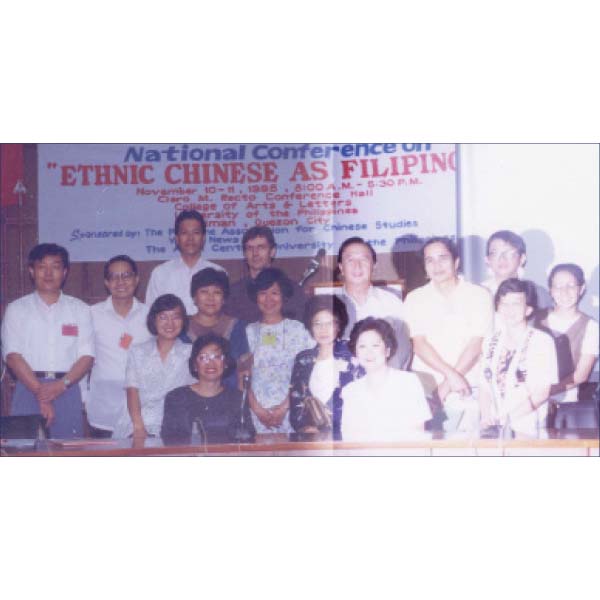
Congratulations to Kaisa on its 30th anniversary! Turning 30 and still thriving symbolizes a major achievement and a coming of age. From its humble beginnings, when it was paid little attention and regarded as a “fringe group,” not least by some Chinese Filipinos (Tsinoys) themselves, it has achieved public recognition as a significant movement of integrating the Tsinoys into Philippine society.
Many of the actions and activities of Kaisa have contributed immensely to the remarkable changes that have taken place over the last three decades in how Filipinos perceive their ethnic Chinese compatriots.
For one, the Tsinoys are no longer a “silent minority.” The younger generations have become visibly active in Philippine social and political life, unafraid to articulate their needs and perspectives in public and generally gaining much greater acceptance in the Philippines.
This is a tribute to Teresita Ang See, founding president of Kaisa, for her courage, indomitable spirit and devotion to realizing Kaisa’s mission despite countless obstacles and challenges.
Here I also wish to mention the late professor Chinben See, who shared with me his vision of Kaisa when he was teaching at De La Salle University; Go Bon Juan, journalist and opinion maker in World News; Atty. Florencio Mallare, publisher of World News and Joaquin Sy, renowned writer and entrepreneur.
They were among those who introduced me to the world of the Tsinoys and opened the door to a deeper understanding of what it meant to belong to an “ethnic minority.”
I have enjoyed collaborating with Kaisa and personally with Tessy on a variety of projects over the past 30 years.
During my term as director of the China Studies Program at De La Salle University, frequent joint conferences and research projects were undertaken with Kaisa and PACS (Philippine Association for Chinese Studies) on themes such as “Chinese-Filipino Literature in the Philippines,” “China-Philippines Relations” and “Ethnic Chinese as Filipinos.”
These meetings and subsequent publications have sparked keen interest among local scholars to undertake further studies of the ethnic Chinese in the Philippines.
Chinese-Filipino literature, which highlighted the agony of younger generations as they wrestled with the issues of identity, belonging and acceptance in their adoptive country, began to see print.
Through these academic collaborations, the important economic, social and political contributions of the Tsinoys not only in Manila but also at the provincial levels have been highlighted.
These local histories reveal how, through the years, Chinese immigrants have had their lives inter-woven into the fabric of Philippine social, economic and political life.
Apart from the academe, Kaisa has been very active socially and politically. The protest marches in 1993 and 1995 against kidnappings were historic turning points, announcing to the government and the general public that the Tsinoys were no longer willing to be acquiescent victims of corrupt officials and public security agents.
With Kaisa at the helm, the unprecedented rallies gave notice that the Chinese in the Philippines were more than ready to speak up and act publicly to defend their interests as Filipino citizens. For the first time, they were collectively and openly articulating their rights, as citizens, to equal political treatment.
Today, Kaisa continues to make progress on many fronts. There is more acknowledgement that the Chinese in the Philippines constitute an asset rather than a liability. The term Tsinoy has become widely used.
The popular Tsinoy television program “Pinpin” pioneered by Kaisa has brought visibility to the Tsinoys living in the Philippines – helping to dispel the stereotypes and myths about the Chinese, simultaneously introducing the depth and width of Chinese adaptation to life in the Philippines over the centuries.
Among young Tsinoys, I sense a strong pride in both being Filipino and being Chinese.
Increasingly, they are contributing to philanthropy. Major foundations have been created by Tsinoys to support health and education for those living in poverty.
The services of the Tsinoys to those in need have greater visibility today through Tulay and other media, even though there is still a strong tendency to keep a low profile.
I was particularly impressed with the enthusiasm and dedication of Kaisa members during the emergency relief for victims of typhoons Ondoy and Yolanda in recent years. In both instances, the Amity Foundation, for which I work, was able to raise funds for the distribution of relief goods to victims of both typhoons.
Kaisa was able to mobilize hundreds of volunteers and donors to prepare relief packages and, in the case of Iloilo, to help in the distribution of motorized bancas vital to the livelihoods of fishermen.
Even more impressive was the broad, reliable and professional network of local partners with which Kaisa worked during the relief operations which included local Chinese communities and the Philippine Red Cross. It was touching to see young Tsinoys working hand-in-hand with local youth to bring relief to local communities in need.
In an era of extremism and disruption, organizations such as Kaisa are invaluable in encouraging youth to broaden their views, to have inclusive perspectives and inter-ethnic, inter-faith sensibilities.
My warmest wishes and congratulations go to all the leaders, members and staff of Kaisa for the wonderful work they have been doing! May Kaisa continue to grow, flourish and contribute to a more inclusive and sustainable society in the Philippines!
